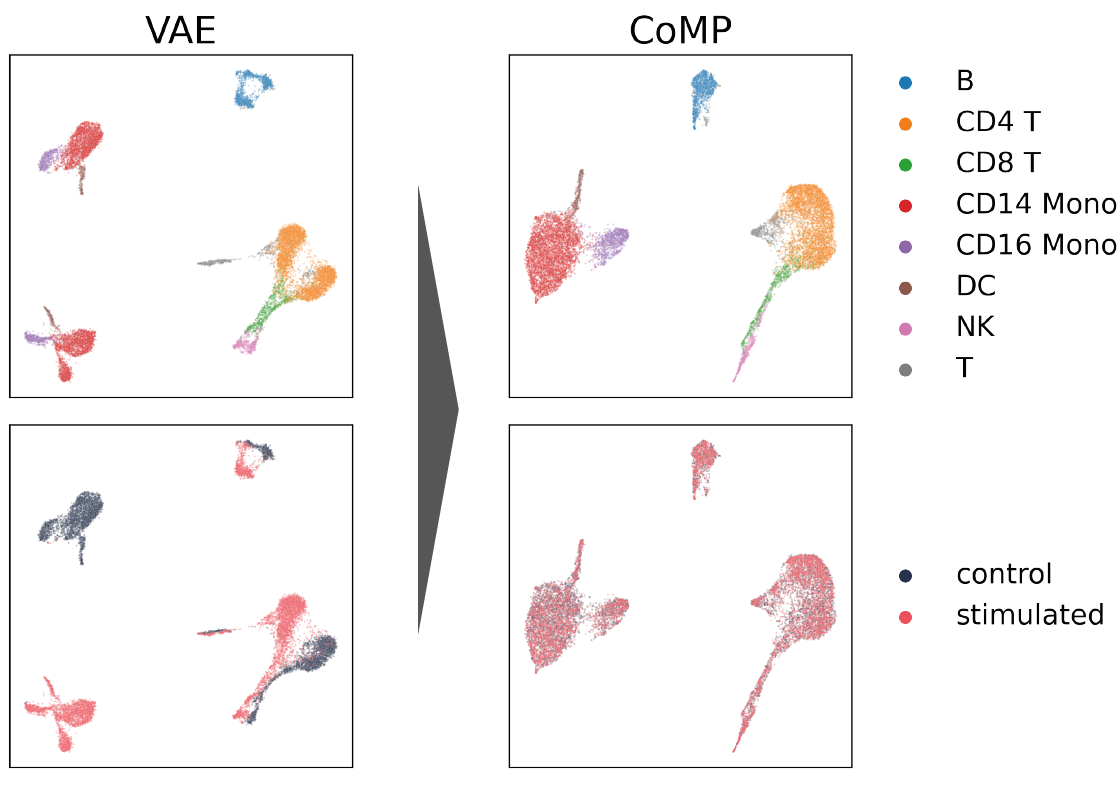Contrastive Mixture of Posteriors (CoMP) for Counterfactual Inference, Data Integration and Fairness
This is the PyTorch implementation of Contrastive Mixture of Posteriors for Counterfactual Inference, Data Integration and Fairness ICML 2022.
Requirements
System requirements
The following environment was used for the experiments, based on the nvidia/cuda:11.0.3-cudnn8-devel-ubuntu20.04 docker image from dockerhub:
- Ubuntu 20.04
- CUDA 11.0.3, cudnn 8
- Python 3.8
Python environment
Running in a virtualenv or container is recommended. To install requirements:
pip install -U pip wheel
pip install -r requirements.txt
Datasets
The model expects two files -- a data file named features.tsv and a file with labels named metadata.tsv, with sample indices as the first column in both files, and with headers as the first row. We set the conditional variable "type" in the metadata file.
The data is prepared in two steps.
Step 1: Download source datasets
First the source datasets need to be downloaded from the following sources and placed into a folder <data-dir>.
Tumour / Cell Line Dataset
There are four files to download and prepare, as follows:
- Metadata file: The Celligner_info.csv file is taken from here. Save the file as
<data-dir>/Celligner_info.csv. - HGNC gene names: The file hgnc_complete_set_7.24.2018.txt can be downloaded from here. Save the file as
<data-dir>/hgnc_complete_set_7.24.2018.txt. - Tumour gene expression data: The TPM expression values can be downloaded from here. Rename this file to
<data-dir>/TCGA_mat.tsv. - Cell Line gene expression data: The data is downloaded from DepMap Public 19Q4 file: CCLE_expression_full.csv here. Rename this file to
<data-dir>/CCLE_mat.csv.
Single cell PBMCs
Data was downloaded from the theislab/trVAE_reproducibility repository. Download kang_count.h5ad from the Google Drive link in the Getting Started section of the README to <data-dir>/kang_count.h5ad.
UCI Adult Income
Data was downloaded from the UCI Machine Learning Repository. Download all adult.{data,names,test} files from the data directory to the <data-dir> directory.
Step 2: Process data
Next we process the data prior to training the model. Specify a separate output folder <processed-data-x> for each of the datasets and run the following:
# Tumour / Cell line data
python3 data/process_celligner_data.py --input-dir <data-dir> --output-dir <processed-data-tcl> --top-var-number 8000
# Kang et al. PBMC scRNA-seq under INFb stimulation
python3 data/process_kang.py --input-dir <data-dir> --output-dir <processed-data-kang> --top-var-number 2000
# UCI Income data
python3 data/process_uci_income.py --input-dir <data-dir> --output-dir <processed-data-uci>
Training
Evaluation metrics are computed at the end of the training loop for the best checkpoint (by validation loss).
In all the commands below the <processed-data> below should be the path the directory containing the files listed in the previous section. <output-dir> should be the desired directory in which to save the outputs. It will be created if it does not exist.
To run the code using only the CPU, omit the --use-cuda flag in the arguments to the run script.
Tumor / cell-line
python3 run.py --data-dir <processed-data-tcl> --output-dir <output-dir> --dataset tumour_cl --model comp --hidden-dim 512 --latent-dim 16 --num-layers 3 --use-batchnorm 1 --batch-size 5500 --num-epochs 4000 --learning-rate 0.0001 --penalty-scale 0.5 --kl-beta 1e-07 --seed 80244971 --use-cudaSingle cell PBMCs
python3 run.py --data-dir <processed-data-kang> --output-dir <output-dir> --dataset kang --model comp --hidden-dim 512 --latent-dim 40 --num-layers 3 --use-batchnorm 1 --batch-size 512 --num-epochs 10000 --learning-rate 1e-06 --penalty-scale 1.0 --kl-beta 1e-07 --seed 196117 --use-cudaUCI Adult Income
python3 run.py --data-dir <processed-data-uci> --output-dir <output-dir> --dataset uci-income --model comp --hidden-dim 64 --latent-dim 16 --num-layers 2 --use-batchnorm 1 --batch-size 4096 --num-epochs 10000 --learning-rate 0.0001 --kl-beta 1.0 --penalty-scale 0.5 --seed 116983357 --use-cudaEvaluation
An example notebook to evaluate the summary metrics is given in evaluation.ipynb.
Results
Our model achieves the following performance on :
Tumour / Cell Line Dataset
| Model | silhouette | kbet | mean-silhouette | mean-kbet |
|---|---|---|---|---|
| VAE | 0.658 | 0.974 | 0.803 | 0.581 |
| CVAE | 0.554 | 0.931 | 0.684 | 0.571 |
| VFAE | 0.168 | 0.258 | 0.198 | 0.188 |
| trVAE | 0.096 | 0.163 | 0.138 | 0.123 |
| Celligner | 0.082 | 0.525 | 0.568 | 0.226 |
| CoMP (ours) | 0.023 | 0.160 | 0.094 | 0.101 |
UCI Adult Income
| Model | Gender Acc. | Income Acc. | silhouette | kbet |
|---|---|---|---|---|
| Original data | 0.796 | 0.849 | 0.067 | 0.786 |
| VAE | 0.764 | 0.812 | 0.054 | 0.748 |
| CVAE | 0.778 | 0.819 | 0.054 | 0.724 |
| VFAE-sampled | 0.680 | 0.815 | - | - |
| VFAE-mean | 0.789 | 0.805 | 0.046 | 0.571 |
| trVAE | 0.698 | 0.808 | 0.066 | 0.731 |
| CoMP (ours) | 0.679 | 0.805 | 0.011 | 0.451 |
Reference
If you find this code useful, do cite the following paper in your publication:
@inproceedings{foster2022contrastive,
title={Contrastive Mixture of Posteriors for Counterfactual Inference, Data Integration and Fairness},
author={Foster, Adam and Vez{\'e}r, {\'A}rpi and Glastonbury, Craig A and Creed, P{\'a}id{\'\i} and Abujudeh, Samer and Sim, Aaron},
booktitle={International Conference on Machine Learning},
pages={6578--6621},
year={2022},
organization={PMLR}
}
